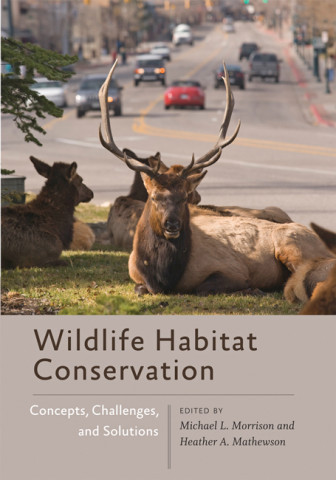
Reviews
The authors' efforts to provide many clear, concrete examples of how to put theory in practice is particularly noteworthy.
Illuminating ways to bridge the gap between landscape ecology and wildlife management, Wildlife and Landscapes makes a scientifically sound and unique contribution that can be used beneficially by professionals in either field. Logical, deductive, and effective, the book bright-lines how real progress can be made when managers and landscape ecologists work together in collaborations that prioritize clear communication and empathetic understanding.
Bringing the idea of larger spatial scale thinking to wildlife conservation and management, this excellent book is a valuable resource not only for practitioners but also for the informed public who want to get the bigger picture.
This book is a timely piece that bridges the gap between practicing wildlife managers and landscape ecologists. It provides an important contribution in the search for creative ways of managing habitats to benefit diverse wildlife species.
Wildlife Management and Landscapes blends traditional and new techniques, field application and ecological theory, wildlife management and landscape ecology to provide students, managers, and researchers with the knowledge and tools they need to incorporate large-scale patterns and processes into wildlife management and conservation.
In the twenty-first century, we have heard a clarion call to recognize that our most vexing wildlife conservation challenges must be addressed at a landscape scale. Finally, we have a volume that integrates landscape ecology and wildlife management such that practitioners and students in both disciplines have a template to move forward in meeting these challenges.
I am amazed by what has been synthesized and created in Wildlife Management and Landscapes. This book will change the way you think about wildlife management. More importantly, it provides a roadmap for how wildlife managers and landscape ecologists can work together to maintain and enhance wildlife habitat.
Book Details
List of Contributors
Foreword
Preface
Acknowledgments
Part I. Understanding Habitat on Landscapes
Chapter 1. The Landscape Perspective in Wildlife and Habitat Management
Chad J. Parent and Fidel Hernández
Ch
List of Contributors
Foreword
Preface
Acknowledgments
Part I. Understanding Habitat on Landscapes
Chapter 1. The Landscape Perspective in Wildlife and Habitat Management
Chad J. Parent and Fidel Hernández
Chapter 2. Wildlife Management and the Roots of Landscape Ecology
James A. Martin and John M. Yeiser
Chapter 3. Wildlife–Landscape Relationships: A Foundation for Managing Habitats on Landscapes
Michael L. Morrison and William M. Block
Part II. Establishing a Landscape Foundation for Wildlife Managers
Chapter 4. Essential Concepts in Landscape Ecology for Wildlife and Natural Resource Managers
Humberto L. Perotto-Baldivieso
Chapter 5. Using Landscape Ecology to Inform Effective Management
Joseph A. Veech
Chapter 6. Translating Landcover Data Sets into Habitat Features
David D. Diamond and Lee F. Elliott
Chapter 7. Influence of Habitat Loss and Fragmentation on Wildlife Populations
Amanda E. Martin, Joseph R. Bennett, and Lenore Fahrig
Chapter 8. Data Collection and Quantitative Considerations for Studying Pattern–Process Relationships on Landscapes
Jacqueline L. Frair and Guillaume Bastille-Rousseau
Chapter 9. Part II Synthesis: Establishing a Landscape Foundation for Wildlife Managers
David M. Williams
Part III. Establishing a Wildlife Management Foundation for Landscape Ecologists
Chapter 10. Managing Wildlife at Landscape Scales
John W. Connelly and Courtney J. Conway
Chapter 11. Improving Communication between Landscape Ecologists and Managers: Challenges and Opportunities
Kerri T. Vierling, Joseph D. Holbrook, Jocelyn L. Aycrigg, Teresa C. Cohn, and Leona K. Svancara
Chapter 12. Developing Useful Spatially Explicit Habitat Models and Decision-Support Tools for Wildlife Management
Neal D. Niemuth, Michael E. Estey, and Ronald D. Pritchert
Chapter 13. Managing Landscapes and the Importance of Conservation Incentive Programs
Mark J. Witecha and Todd R. Bogenschutz
Chapter 14. Part III Synthesis: Establishing a Wildlife Management Foundation for Landscape Ecologists
David M. Williams
Part IV. Translating Landscape Ecology to Management
Chapter 15. Age, Size, Configuration, and Context: Keys to Habitat Management at All Scales
Jeffrey K. Keller
Chapter 16. A Joint Venture Approach
Gregory J. Soulliere and Mohammed A. Al-Saffar
Chapter 17. Translating Landscape Ecology to Management: A Landscape Conservation Cooperatives Approach
Cynthia A. Jacobson, Amanda L. Sesser, Elsa M. Haubold, Kevin M. Johnson, Kimberly A. Lisgo, Betsy E. Neely, Fiona K. A. Schmiegelow, Stephen C. Torbit, and Greg Wathen
Chapter 18. Mapping Priority Areas for Species Conservation
Casey A. Lott, Jeffery L. Larkin, Darin J. McNeil, Cameron J. Fiss, and Bridgett E. Costanzo
Chapter 19. Nongovernmental Organizations: Their Role in and Approach to Landscape Conservation
Jodi A. Hilty, Karl A. Didier, and Jon P. Beckmann
Chapter 20. Part IV Synthesis: Translating Landscape Ecology to Management
David M. Williams
Index





